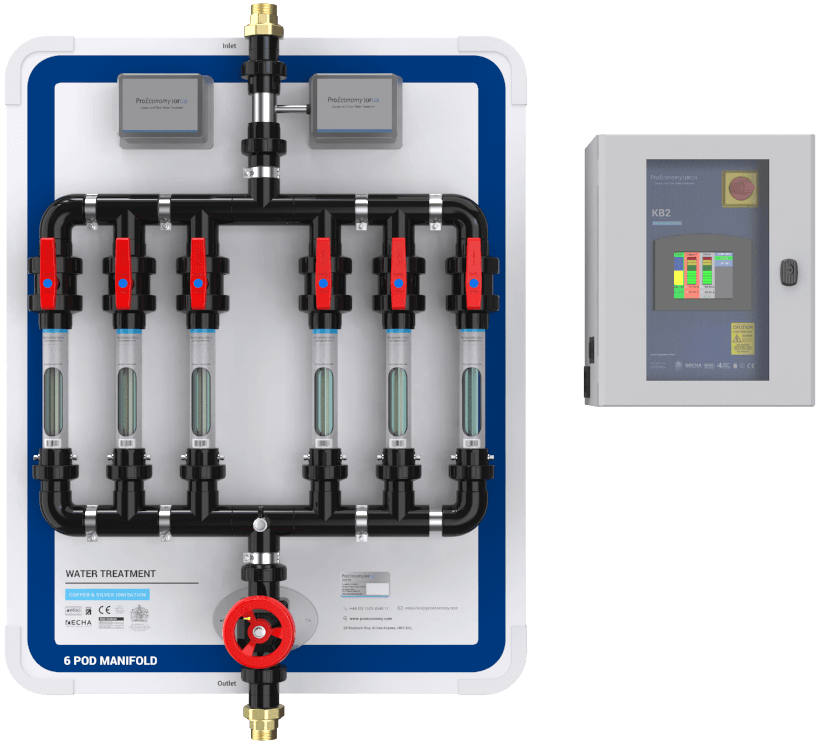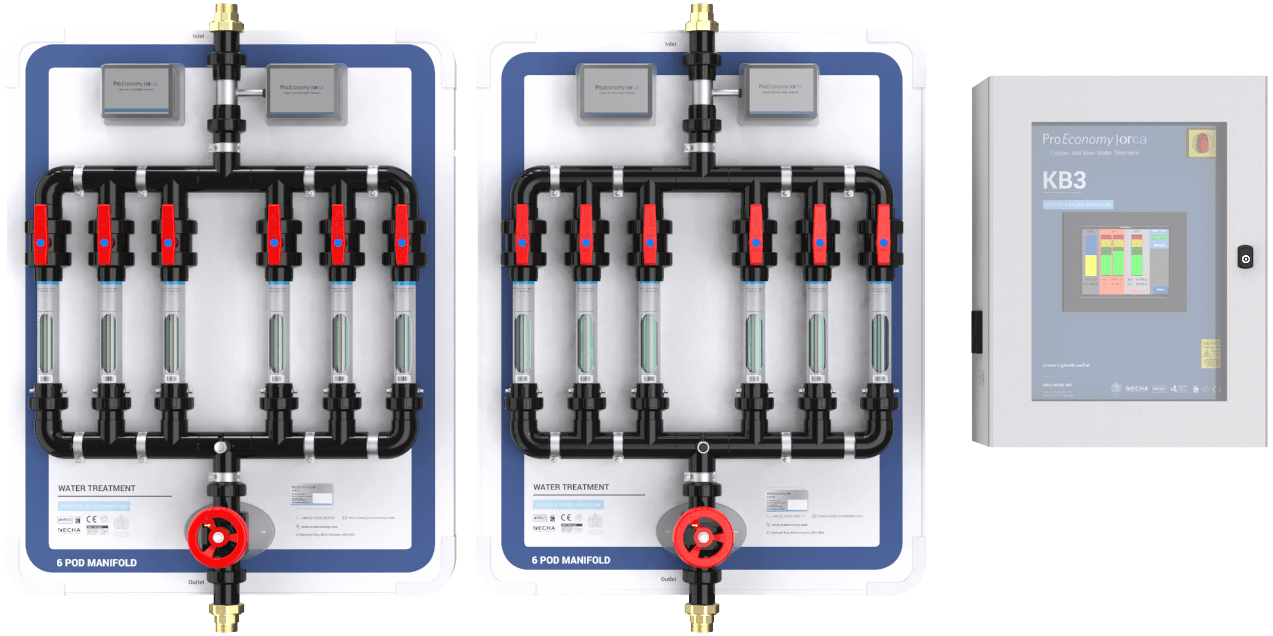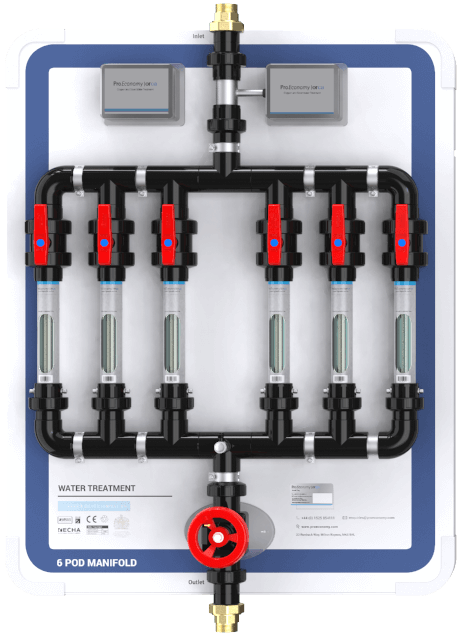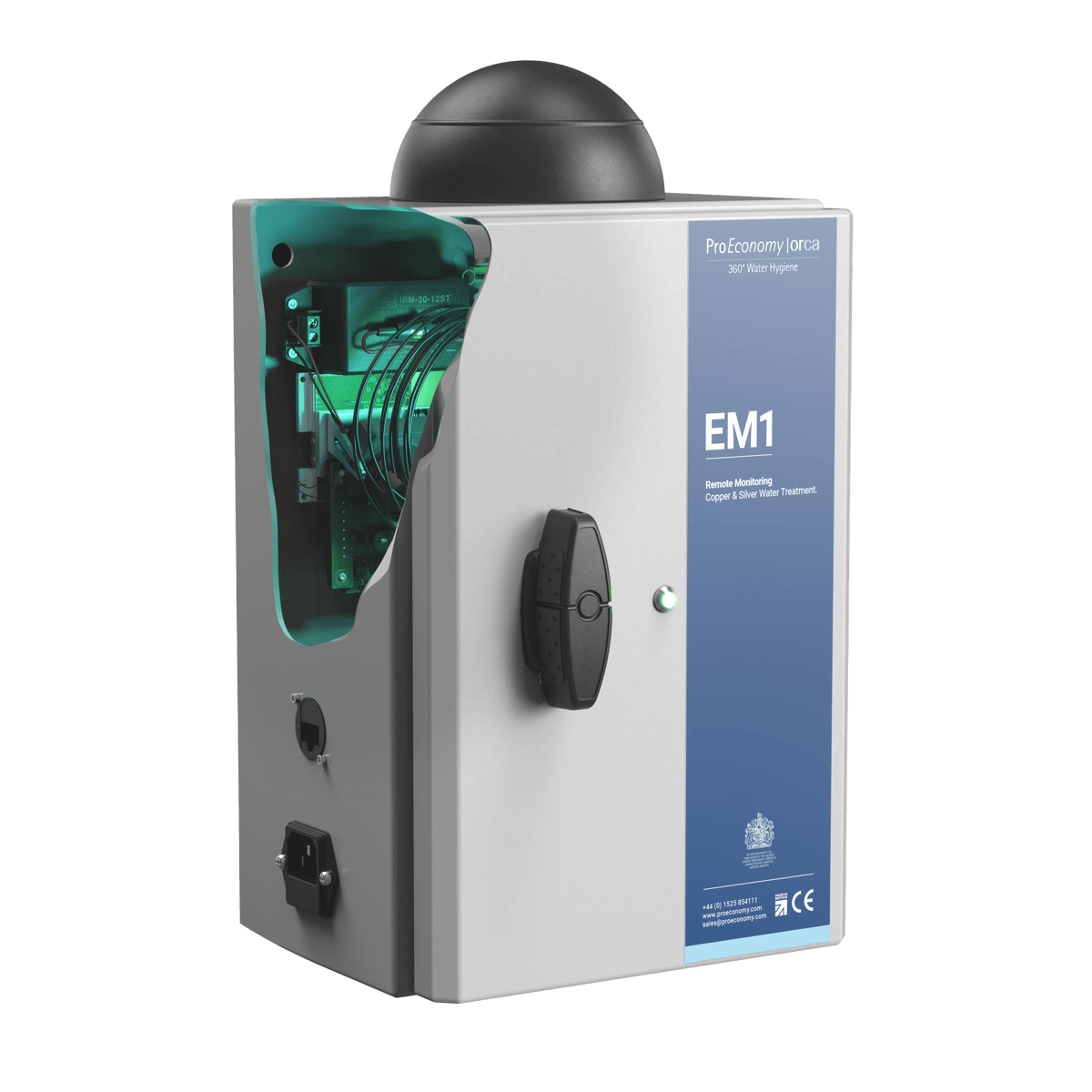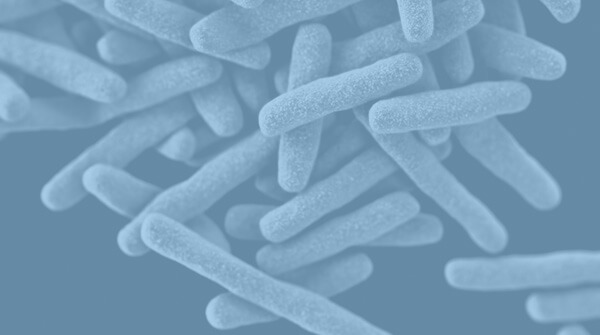Copper and Silver Ionisation
At ProEconomy we offer advanced water treatment and Legionella control with our copper and silver ionisation system, The Orca.
How Does Copper and Silver Ionisation Work?
Copper and silver ionisation is a relatively new modality for Legionella control, Pseudomonas control and other pathogens in water systems. Although the use of copper and silver ionisation was first recorded in the USA in 1990 (Lin et al., 2011), it was actually pioneered by NASA in the 1960s (Albright et al., 1967).
Copper and silver ionisation involves the generation of copper and silver ions in water. This happens when water flows through the turbine of a flow sensor sending a signal to the system control unit, which then passes a low DC current between two copper and two silver electrodes located in an electrode chamber.
As a result of this, biocide tolerance is unlikely to occur when using copper and silver ionisation to control pathogens in water systems.
Although a relatively new modality, copper and silver ionisation is a proven method of water treatment that is surpassing its counterparts in Legionella control. You can find out more about other water treatment methods below.
Benefits Of Copper and Silver Ionisation
As well as effectively controlling Legionella, Pseudomonas and other water borne pathogens, copper silver ionisation has a range of benefits that make it a safe, approved and advanced water treatment method. You can find out more about the benefits of copper and silver ionisation and our Orca system below.
Residual Effect of Copper and Silver
A 1994 study on copper and silver ionisation of a hospital water distribution system found complete inactivation of Legionella pneumophila and L. bozemanii when exposed to 0.4 mg/L copper and 0.04 mg/L silver, and continued residual inactivation two months after the copper and silver water ionisation unit was switched off (Liu et al. 1994).
Another study by Liu et al. (1998) evaluated copper-silver ionisation systems installed onto the hot water re-circulation lines of two hospital buildings colonised with L. pneumophila, compared with a control also colonised with L. pneumophila.
Four weeks after activation of the system, distal site positivity for Legionella in the first test building dropped to zero. After operating for 16 weeks the system was disconnected and installed onto the second test building. Twelve weeks of disinfection reduced the distal site positivity for Legionella in the second test building to zero. Legionella recolonisation did not occur in the first test building for 6-12 weeks and in the second test building for 8-12 weeks after inactivation of the system. A significantly higher copper concentration was found in the biofilm taken from a sampling device than in than that from water. This was taken to be the reason the copper-silver ionisation system had a residual effect and prevented early recolonisation.
Legionella Control At Low Temperatures
Legionella pneumophila thrives in temperatures between 20 and 45°C and multiplies rapidly in untreated or ineffectively treated water systems. Although there are various methods of Legionella control, not all of them will work for both cold and hot water.
Copper and silver ionisation for Legionella control is one of the current techniques that is not only proven to be effective for Legionella control (Landeen et al. 1989, Lin et al. 2011, Lin et al. 1996, BSRIA TN6/96) but also works at both hot and cold water temperatures (Liu et al. 1994, Liu et al. 1998, Stout et al. 1998, Kusnetsov et al. 2001, Stout and Yu 2003 and Chen et al. 2008).
Results of tests carried out during a research project completed in 1996 by BSRIA in the UK showed that copper and silver ionisation was effective against Legionella bacteria in both cold and hot water systems with water temperatures as low as 35°C. Meanwhile, studies of hot water systems in hospitals in the USA suggested that copper and silver ionisation eliminated L. pneumophila contamination in systems with relatively low water volume (<200 L) and without hot water storage tanks (Liu et al. 1994, Coville et al. 1993).
A new hospital building has been using the Orca copper and silver ionisation system since opening in 2011 with deliberately reduced water temperatures. 100% Legionella control and 90% Pseudomonas control at temperatures between 17 and 45 °C has been achieved. The installation of a copper and silver ionisation system also minimised the use of thermostatic mixing valves due to the lower temperatures. This therefore eliminates the need for mixing valve maintenance regimes and corresponding costs. In addition, by allowing the system to operate at lower temperatures, a 33% reduction in energy consumption associated with heating water was achieved.
These results show that, when temperatures are lower than those recommended by authorities, having copper and silver as a secondary Legionella control modality will ensure the water system is still protected. You can read a full study on Legionella control at low temperatures below.
No COSHH Issues
Copper and silver ionisation provides no COSHH issues, unlike Chlorine and Chlorine Dioxide water treatment methods. Adding to this, it is non-toxic to the environment and safe to handle.
Scientific Evidence Of Copper and Silver Water Treatment
HSE and Copper Silver Ionisation
HSE has backed copper as a biocide for essential use.
ProEconomy have worked tirelessly over the last 25 years to create the reputation that we have. Furthermore, we have helped to establish copper and silver ionisation as an essential method for Legionella control.
Nick Bedford MD of ProEconomy is positive about the derogation; ‘the review of copper as a biocide by the EC had a big impact on us and we are glad that HSE backed copper and silver ionisation as an essential water treatment method. We hope to build on this and are positive that there will be positive changes for copper and silver ionisation in the new ACoP L8. It’s time that ionisation’s contribution to Legionella control has a more balanced standing within official legislation.’
For more information contact Nick Bedford at nick@proeconomy.com.
Case Studies
- Clinical Infectious Diseases
Liu Z., Stout, J.E., Boldin, M., Rugh, J., Diven, W.F., and Yu, V.L., (1998), Intermittent use of copper-silver ionization for Legionella control in water distribution systems: a potential option in buildings housing individuals at low risk of infection. Clin Infect Dis 26: 138–140.
Of three buildings colonised with Legionella, two were fitted with copper-silver ionisation systems, with the third building left as a control. Positive tests for Legionella in the first building dropped to zero within four weeks, and to zero within the second building within twelve weeks. Recolonisation didn’t occur in the first test building for 6-12 weeks after the CSI system had been switched off, and in the second building for 8-12 weeks. The control building remained positive throughout.
- Infection Control Hospital Epidemiology
Stout, J.E. & Yu, V.L., (2003), Experiences of the first 16 hospitals using copper-silver ionisation for Legionella control: implications for the evaluation of other disinfection modalities, Infect Control Hosp Epidemiol 24(8): 563-8.
The first 16 hospitals in the USA to install copper-silver ionisation were surveyed twice, in 1995 with a follow-up in 2000. All had reported cases of hospital-acquired legionnaires’ disease prior to installation, and 75% had attempted other control methods. In 1995 50% of the hospitals reported 0% positivity, and 43% still reported 0% in 2000. Moreover, no cases of hospital-acquired legionnaires’ disease had occurred in any hospital since 1995.
- American Journal of Infection Control
Miuetzner, S. et al, (1997), Efficacy of thermal treatment and copper-silver ionization for controlling Legionella pneumophila in high-volume hot water plumbing systems in hospitals, American Journal of Infection Control, Vol. 25, No. 6, p. 452-457.
Hot water (>60 oC) was flushed through fixtures for 10 minutes. Copper-silver ionisation units were installed upstream from hot water tanks. It was found that four heat-flush treatments failed to provide long-term control of Legionella, whereas ionisation reduced the recovery rate of Legionella from 108 outlets from 72% to 2% within 1 month and maintained effective control for at least 22 months.
- Clinical Infectious Diseases
Mòdol, J. et al, (2007), Hospital-Acquired Legionnaires Disease in a University Hospital: Impact of the Copper-Silver Ionization System, Clinical Infectious Diseases, Vol. 44, No. 2, p. 263-265
Hospital-acquired legionnaires’ disease had been endemic in a Barcelona hospital for many years, with various control methods tried and failed. After installation of a copper-silver ionisation system, Legionella colonisation decreased significantly and the incidence of hospital-acquired legionnaires’ disease decreased dramatically from 2.45 to 0.18 cases per 1000 patient discharges.
- The Journal of Infectious Diseases
Liu, Z. et al (1994), Controlled Evaluation of Copper-Silver Ionization in Eradicating Legionella pneumophila from a Hospital Water Distribution System, The Journal of Infectious Diseases, Vol. 169, No. 4, pp. 919-922
A copper-silver ionisation system was effective in eradicating Legionella from the hot water distribution system of a hospital building were identified as easy installation and maintenance, non-toxic by products well below EPA standards, stable and easily measured residual that was unaffected by high temperatures, and a margin of safety if the system stopped working as recolonisation by Legionella required more than 2 months.
References
- References
Albright C.F., Nachum R., Lechtman M.D. (1967) Development of an electrolytic silver-ion generator for water sterilization in Apollo spacecraft water systems: Final Report. Apollo Applications Program, Manned Spacecraft Center, NASA:Houston. Available online: http://www.clearwaterpoolsystems.com/nasa-connection.html (Accessed July 2015).Babalova M., Blahova J., Lesicka-Hupkova M., Krcmery V., Kubonova K. (1995). Transfer of ceftazidime and aztreonam resistance from nosocomial strains of Xanthomonas (Stenotrophomonas) maltophilia to a recipient strain of Pseudomonas aeruginosa ML-1008. Eur. J. Clin. Microbiol. Infect. Dis. 14:925-927.Barbosa, V.L., Thompson, K.C. (2016) Controlling Legionella in a UK hospital using copper and silver ionisation – a case study. Journal of Environmental Chemical Engineering 4(3): 3330 3337.Bedford, B. (2012) Legionella control in water systems using copper and silver ion generation systems. PhD thesis. Cranfield University, UK.Available from: https://dspace.lib.cranfield.ac.uk/bitstream/1826/7983/1/Birgitta_Bedford_Thesis_2012.pdfBiurrun A., Caballero L., Pelaz C., Leon E., Gago A. (1999). Treatment of a Legionella pneumophila colonized water distribution system using copper-silver ionization and continuous chlorination. Infect. Control. Hosp. Epidemiol. 20:426-428.Bollet C., Davin-Regli A., De Micco P. (1995) A simple method for selective isolation of Stenotrophomonas maltophilia from environmental samples. Applied and Environmental Microbiology 61(4):1653–1654. http://www.ncbi.nlm.nih.gov/pmc/articles/PMC1388425/pdf/hw1653.pdfBougeard C.M.M., Goslan E.H., Jefferson B., Parsons S.A. (2010). Comparison of the disinfection by-product formation potential of treated waters exposed to chlorine and monochloramine. Water Research 2010;44(3):729-740.Brooke J.S. (2012) Stenotrophomonas maltophilia: an emerging global opportunistic pathogen. Clin Microbiol Rev 25(1):2–41. 10.1128/CMR.00019-11Building Services Research and Information Services (1996). Application Guide AG 2/93. Water treatment for building services systems. Building Services Research and Information Services (BSRIA) Technical Notes TN6/96 1996. Ionisation water treatment for hot and cold water services.Chaudri A.M., Knight B.P, Barbosa-Jefferson V.L., Preston S., Paton G.I., Killham K., Coad N., Nicholson F.A., Chambers B.J., McGrath S.P. (1999) Determination of acute Zn toxicity in pore water from soils previously treated with sewage sludge using bioluminescence assays. Environ. Sci. and Technol. 33: 11. 1880–1885.Chen Y.S., Lin Y.E., Liu Y.C., Huang W.K., Shih H.Y., Wann S.R., Lee S.S. et al. (2008). Efficacy of point-of-entry copper-silver ionisation system in eradicating Legionella pneumophila in a tropical tertiary care hospital: implications for both hospitals contaminated with Legionella in both hot and cold water. Journal of Hospital Infection. 68:152-158.Colville, A.; Crowley, J.; Dearden, D.; Slack, R.C.B.; Lee, J.V. (1993). Outbreak of Legionnaires’ disease at University Hospital, Nottingham: epidemiology, microbiology and control. Epidemiol Infect 110:105-16.DH (2012). Report on the review of evidence regarding the contamination of wash-hand basin water taps within augmented care units with Pseudomonads. 43 pp.DH, Estates and Facilities (2013). HTM 04-01 – Addendum: Pseudomonas aeruginosa – advice for augmented care units. 37 pp.Read HereDH Estates and Facilities Division (2016) Health Technical Memorandum 04-01: Safe water in healthcare premises, Part A: Design, installation and commissioning 2016. Health Technical Memorandum 04-01: Safe water in healthcare premises, Part B: Operational management. Department of Health. 2016. London, UK. [Online]. Available from: https://www.gov.uk/government/uploads/system/uploads/attachment_data/file/524882/DH_HTM_0401_PART_B_acc.pdf [Accessed April 2017].
Kilvington S., Price J. (1990) Survival of Legionella pneumophila within cysts of Acanthamoeba polyphaga. Journal of Applied Bacteriology 68:519-525.Huang, H-I; Shih, H-Y; Lee, C-M; Yang, TC; Lay, J-J; Lin, YE (2008). In vitro efficacy of copper and silver ions in eradicating Pseudomonas aeruginosa, Stenotrophomonas maltophilia and Acinetobacter baumannii: Implications for on-site disinfection for hospital infection control. Water Research 42(1-2): 73–80.Kusnetsov J., Livanainen E., Elomaa N., Zacheus O., Martikainen P.J. (2001). Copper and silver ions more effective against Legionellae then against Mycobacteria in a hospital warm water system. Wat. Res. 35(17):4217-4225.Landeen, L.K.; Yahya, M.T.; Gerba, C.R. (1989) Efficacy of copper and silver ions and reduced levels of free chlorine in inactivation of Legionella pneumophila. Appl Environ Microbiol 55:3045-50.Lin Y., Stout J.E., Yu V.L. (2011). Controlling Legionella in Hospital Drinking Water: An Evidence-Based Review of Disinfection Methods. Infection Control and Hospital Epidemiology. 32(2):166-173.Lin Y.E., Vidic R.D., Stout J.E., Yu V.L. (1998). Legionella in water distribution systems. J Am Water Works Assoc. 90:112–21.Lin, Y.S.E.; Vidic, R.D.; Stout, J.E.;Yu, V.L. (1996) Individual and combined effects of copper and silver ions on inactivation of Legionella pneumophila. Wat. Res. 30:1905-1913.Liu Z., Stout J.E., Tedesco L., Boldin M., Hwang C., Diven W.F., Yu V.L. (1994). Controlled evaluation of copper-silver ionisation in eradicating Legionella from a hospital water distribution system. J. Infectious Disease. 169:919-922.Liu Z., Stout J.E., Boldin M., Rugh J., Diven W.F., Yu V.L. (1998). Intermittent use of copper-silver ionisation for Legionella control in water distribution systems: A potential option in buildings housing individuals at low risk of infection. Clinical Infectious Diseases. 26:138-140.Miuetzner S., Schwille R.C., Farley A., Wald R.R., Ge J.H., States S.J., Libert T., Wadowsky R.M. (1997). Efficacy of thermal treatment and copper-silver ionization for controlling Legionella pneumophila in high-volume hot water plumbing systems in hospitals. The Association for Professionals in Infection Control and Epidemiology, Inc. 17(46):813-866.Nguyen M.H, Stout J.E., Yu, V.L. (1991) Legionellosis. Infect Dis Clin N Am 5(3):561-584.PHE (2017). Monthly Legionella Report: December 2016. PHE publications gateway number: 2016569 https://www.gov.uk/government/uploads/system/uploads/attachment_data/file/582431/Monthly_LD_Report_-_December_16.pdf
Sidari F.P., Stout J.E., van Briesen J.M. (2004). Keeping Legionella out of water systems. J. Am. Water Works Assoc 96:111-119.Quick J., Cumley N., Wearn C.M., Niebel M., Constantinidou C., Thomas C.M., Pallen M.J., Moiemen N.S., Bamford A., Oppenheim B., Loman N.J. (2014). Seeking the source of Pseudomonas aeruginosa infections in a recently opened hospital: an observational study using whole-genome sequencing. British Medical Journal Open 2014(4):e006278. Doi:10.1136/bmjuopen-2014-006278.Rohr U., Senger M., Selenka F., Turley R., Wilhelm M. (1999). Four years of experience with silver-copper ionization for control of Legionella in a German university hospital hot water plumbing system. Clinical Infectious Diseases. 29:1507-1511.Stout J.E., Lin Y.E., Goetz A.M., Muder R.R. (1998). Controlling Legionella in hospital water systems: Experience with the superheat-and-flush method and copper silver ionization. Infection control and Hospital Epidemiology. 19(12):911-914.Stout J.E., Yu V.L. (2003). Experiences of the first 16 hospitals using copper silver ionisation for Legionella control: Implications for the valuation of other disinfection modalities. Infection Control and Hospital Epidemiology 24(8):563-568.Walker J., Moore G. (2015). Pseudomonas aeruginosa in hospital water systems: biofilms, guidelines, and practicalities. Journal of Hospital Infection 89(4):324–327.

